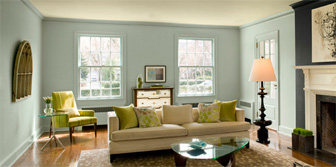Eco-friendly Paints
You literally have hundreds of paints to choose from when you go to your local paint or home improvement store, but selecting a durable, eco-friendly paint may require a bit more research. Here are some helpful tips and information so you can learn what key qualities set eco-friendly paints apart from the rest.Benjamin Moore's® Natura® Interior Paint is one of the greenest paints on the market. It has zero VOCs and is virtually odorless without sacrificing style or performance. Natura's® quick drying, virtually odorless formula allows you to use your room the same day it's painted.

Due to environmental regulations and increasing consumer demand, paint companies have developed new interior and exterior residential paints that emit little or no VOCs (pollutants known as volatile organic compounds) by using water as a base instead of traditional, petroleum-based oil solvents. "Low-VOC" paints must meet the EPA standard of a maximum 200 grams volatile compound per liter of paint. Green Seal — a non-profit organization dedicated to improving environmental standards for paint and other products — has developed a certification process that limits low-VOC paints to 50 grams of VOC per liter. They may cost a bit more but you can purchase ultra low-VOC paints, which are labeled "zero-VOC" and have less than 5 grams of volatile compound per liter.
Natural paints, which tend to cost more, are usually made from citrus and other plant ingredients, milk protein or clay. One of the most common natural paints is clay paint, which is composed of earth-based minerals and uses mostly water as a natural paint solvent. If you enjoy an earthy, adobe look for your home, a coat of organic clay paint may make a good choice. Your selection of clay colors range from natural earth tones to an assortment of blue, white, and orange tints. Clay paints adhere readily to most surfaces found inside a house and require only two coats of paint. The downside is that these paints are usually more expensive than petroleum-based paint and come in a limited range of colors or textures.
Note: Clay paints can only be used indoors and once painted, your walls cannot be scrubbed, washed, or wiped without risk of damaging the surface. You can remedy this problem by using a low-VOC sealer.
A reasonably inexpensive green alternative to traditional paint is lime wash. Limestone, a calcium-based mineral, is combined with water to form a simple, natural paint that is the basis of all whitewashes. Lime wash can be used indoors or outdoors. Once applied it sinks into its subsurface to form a unique, antique look. Surfaces that take well to lime washing are brick, wood, plaster, and concrete because they are porous.
Note: Although 100% natural, limestone is corrosive to both eyes and skin, so wear gloves and goggles during application.
Milk paints are virtually odorless and are made using the milk protein, casein and lime. They contain no solvents, preservatives or biocides, though some do have synthetic ingredients like acrylic and vinyl. They come in powdered form and once opened or mixed with water, they need to be used quickly to avoid clumping. Like clay, milk is intended as an interior paint and only comes in a matte finish.


